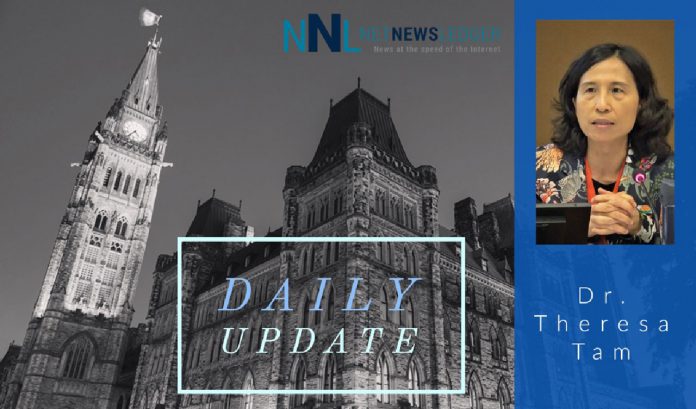OTTAWA – COVID-19 Update – As the resurgence of COVID-19 activity continues in Canada, we are tracking a range of epidemiological indicators to monitor where the disease is most active, where it is spreading and how it is impacting the health of Canadians and public health, laboratory and healthcare capacity. The following is the latest summary on national numbers and trends, and the actions we all need to be taking to maintain COVID-19 at manageable levels across the country.
Since the start of the pandemic, there have been 618,646 cases of COVID-19, including 16,233 deaths reported in Canada; these cumulative numbers tell us about the overall burden of COVID-19 illness to date. Though many areas continue to experience high infection rates, it is important to remember that the vast majority of Canadians remain susceptible to COVID-19. This is why it is important for everyone to continue with individual precautions to protect ourselves, our families and our communities.
In addition to testing to confirm COVID-19 infections in laboratories across Canada, the Public Health Agency of Canada’s (PHAC) National Microbiology Laboratory (NML) conducts routine genomic sequencing on approximately five per cent of virus samples. Given the recent emergence of COVID-19 virus variants of concern, which appear to be associated with an increased risk of spread, PHAC has been working with provinces, territories and international partners to enhance monitoring for the presence of any virus variants in Canada. To date, provinces and territories have reported 11 cases of a virus variant first reported in the United Kingdom and no reports of any other variants of concern, including a variant first reported in South Africa. Given these virus variants have been reported in multiple countries, the Government of Canada continues to advise Canadians against non-essential travel outside of Canada and are advising extra caution if you must travel to countries where a variant of concern is circulating.
With the current momentum of the epidemic and continued high rates of infection in many areas of the country, rapid accumulation of cases will continue until we can make significant progress in interrupting spread. At this time, there are 78,849 active cases across the country. The latest national-level data indicate daily averages of 7,591 new cases (Dec 30 – Jan 5). COVID-19 is spreading among people of all ages, with high infection rates across all age groups. However, nationally, infection rates remain highest among those aged 80 years and older who are at highest risk for severe outcomes.
Likewise, outbreaks continue to occur in high-risk populations and communities, including hospitals and long term care homes, correctional facilities, congregate living settings, Indigenous communities, and more remote areas of the country. The downstream impacts of weeks and months of elevated disease activity continues to be seen in still rising numbers of severe illness and death, significant disruptions to health services and ongoing challenges for areas not adequately equipped to manage complex medical emergencies.
Nationally, hospitalisations and deaths, which tend to lag behind increased disease activity by one to several weeks are still increasing. Provincial and territorial data indicate that an average of 4,085 people with COVID-19 were being treated in Canadian hospitals each day during the most recent 7-day period (Dec 30 – Jan 5), including 767 of whom were being treated in intensive care units. During the same period, there were an average of 122 COVID-19-related deaths reported daily. This situation continues to burden local healthcare resources, particularly in areas where infection rates are highest. These impacts affect everyone, as the healthcare workforce and health system bear a heavy strain, important elective medical procedures are delayed or postponed, adding to pre-existing backlogs.
While we continue to prepare the way for widespread and lasting control of COVID-19 through safe and effective vaccines, Canada needs a collective effort, from public health authorities and individuals, as a range of public health measures and restrictions are implemented to interrupt rapid spread of the virus. Canadians are urged to continue following local public health advice and to consistently maintain individual practices that keep us and our families safer: stay home/self-isolate if you have any symptoms, follow local public health advice and maintain individual protective practices of physical distancing, hand, cough and surface hygiene and wearing a face mask as appropriate (including when you can not consistently keep two metres apart from people outside your immediate household).
Canadians can also go the extra mile by sharing credible information on COVID-19 risks and prevention practices and measures to reduce COVID-19 in communities and by downloading the COVID Alert app to break the cycle of infection and help limit the spread of COVID-19. Read my backgrounder to access more COVID-19 Information and Resources on ways to reduce the risks and protect yourself and others.
SOURCE Public Health Agency of Canada







